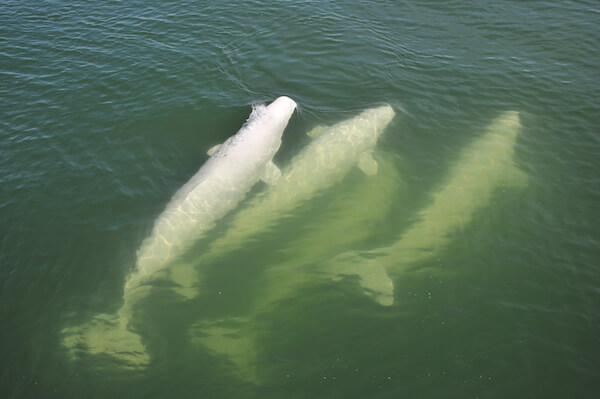By Marie-Maude Rondeau
This summer, I’m working as a responder for the Quebec Marine Mammal Emergency Response Network (QMMERN). I’m part of the mobile team that covers the north shore of the St. Lawrence. What I love about my job is how unpredictable it can be. I know when and where my days will begin, but I never know where they will end: It could be anywhere between Québec City and Kegaska. Nor do I know what might occur during the course of the day or what intervention I might have to make. A minke whale carcass to sample? An entangled humpback to document? A lone seal pup on the beach to be relocated?
It all starts with a call
On September 3, 2021, the QMMERN receives a report for a beluga carcass off the coast of Les Escoumins. A St. Lawrence captain was probably the first person to observe the white carcass drifting in the water. A Parks Canada conservation team then travels to the scene aboard the research vessel L’Alliance to tow the carcass.
Being an endangered species, the St. Lawrence beluga is the subject of special attention, and each carcass is carefully examined to be able to extract as much information as possible. Unfortunately, the more a carcass has decomposed, the less information it is able to reveal. This time, the degree of decomposition was too far advanced to bring the whole carcass to the Faculty of Veterinary Medicine in Saint-Hyacinthe for a necropsy. However, wishing to sample it anyway, we send a few specific portions to the lab for analysis.
Getting to know the carcass
So I make my way to the boat launch at the wharf in Les Escoumins, where the Parks Canada team has secured the carcass with a rope attached to the tail. Accompanied by QMMERN volunteer Sarah Delisle, we start by taking several photos, looking for marks, scars, or notches that might allow us to identify the beluga. We determine that it is a female. Perhaps it is listed in the GREMM catalogue? Our photographs also make it possible to look for signs of human intervention: any sign of lesion or injury is scrupulously documented. Indeed, a propeller, net or fishing line could have left a mark and given us clues as to the cause of mortality.
Important step: we attach a tag to the caudal peduncle. This label is used to indicate that the animal is already being tended to by the QMMERN. The unique number indicated on each tag also makes it possible to track the carcass’s movements. If the carcass is carried farther offshore by the tide or currents, we will know that it is not a new mortality but rather a case that has already been recorded.
Measurements and samples
Now it’s time to take measurements! With our trusty tape measure, we measure the total length of the animal, the circumference in two places and the distance from the rostrum to the navel.
For the remaining sampling, I have to slip on my protective suit. Indeed, whales and seals can carry zoonoses, diseases that are transmitted from animals to humans. Donning a disposable white suit, gloves, a pair of goggles and a mask, I use a sharp knife to cut away a piece of skin and a piece of fat. The skin is mainly used to extract DNA and characterize the animal’s genetic blueprint. Fat, on the other hand, is the main place where lipophilic contaminants accumulate and represents over 90% of the body’s entire contaminant load in cetacean species. Fat therefore makes it possible to assess the animal’s physical condition, detect and quantify these lipophilic contaminants and detect hormonal residues.
A piece of muscle tissue was also taken to gain insight into the beluga’s diet and the presence of certain contaminants that tend to accumulate in the muscles. The liver is important in toxicology: many contaminants are concentrated in this organ and can be found here even in the absence of detectable concentrations in the blood. For this reason, we also take a liver sample.
Lastly, the lower jaw is removed and two biopsies are taken. The teeth will shed more light on the individual’s age, whereas biopsies may allow a match to be made with older biopsies taken by GREMM’s research team while the animal was still alive. Each sample is properly identified and temporarily placed in a cooler before being frozen and sent to the laboratory.
Post-sampling
The day after our intervention, wardens from the Saguenay-St. Lawrence Marine Park tow the carcass far offshore. The decomposition of the animal will thus continue its course as part of the natural cycle of the seabed.
Although the nature of my work may seem sad, for me it is just a way to honour the life of every animal. This beluga’s death will not be in vain and, hopefully, the study of its carcass will allow us to learn more about the challenges faced by this population in order to provide better protection measures.









